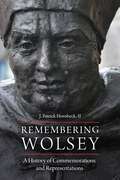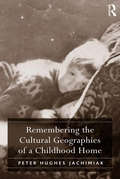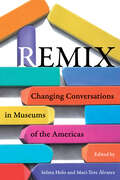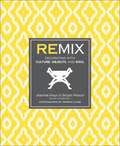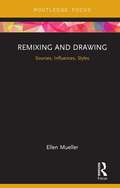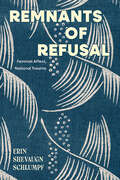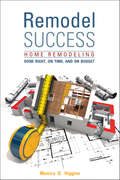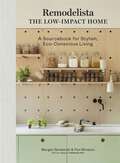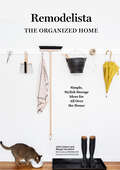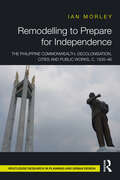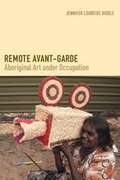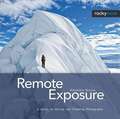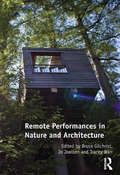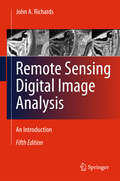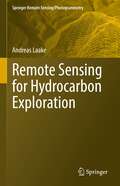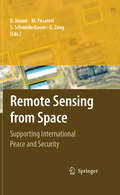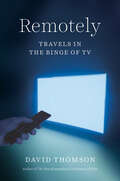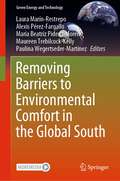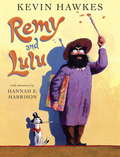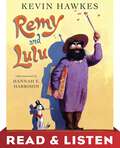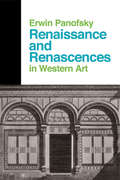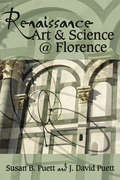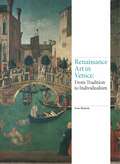- Table View
- List View
Remembering Wolsey: A History of Commemorations and Representations
by J. Patrick IIRemembering Wolsey seeks to contribute to our understanding of historical memory and memorialization by examining in detail the commemoration and representation of the life of Thomas Wolsey, the sixteenth-century cardinal, papal legate, and lord chancellor of England. Hornbeck surveys a wide range of representations of Cardinal Wolsey, from those contemporary with his death to recent mass-market appearances on television and historical fiction, to go beyond previous scholarship that has examined Wolsey only in an early modern context.Remembering Wolsey contributes significantly to the ongoing reimagining of English church history in the years prior to the Reformation. Surveying chronicle accounts, pamphlets, plays, poems, historical fictions, works of historical scholarship, civic pageants and monuments, films, and television programs, the book shows how an extended sequence of authors have told widely varying stories about Wolsey’s life, often through the lens of their own religious and ideological commitments and/or in response to the pressing concerns of their times.
Remembering the Cultural Geographies of a Childhood Home
by Peter Hughes JachimiakUsing an innovative auto-ethnographic approach to investigate the otherness of the places that make up the childhood home and its neighbourhood in relation to memory-derived and memory-imbued cultural geographies, Remembering the Cultural Geographies of a Childhood Home is concerned with childhood spaces and children's perspectives of those spaces and, consequentially, with the personalised locations that make up the childhood family home and its immediate surroundings (such as the garden, the street, etc.). Whilst this book is primarily structured by the author's memories of living in his own Welsh childhood home during the 1970s - that is, the auto-ethnographic framework - it is as much about living anywhere amid the remembered cultural remnants of the past as it is immersing oneself in cultural geographies of the here-and-now. As a result, Remembering the Cultural Geographies of a Childhood Home is part of the ongoing pursuit by cultural geographers to provide a personal exploration of the pluralities of shared landscapes, whereby such an engagement with space and place aid our construction of cognitive maps of meaning that, in turn, manifest themselves as both individual and collective cultural experiences. Furthermore, touching upon our co-habiting of ghost topologies, Remembering the Cultural Geographies of a Childhood Home also encourages a critical exploration of children’s spirituality amid the haunted cultural and geographical spaces and places of a house and its neighbourhood: the cellar, hallway, parlour, stairs, bedroom, attic, shops, cemeteries, and so on.
Remix: Changing Conversations in Museums of the Americas
by Selma Holo and Mari-Tere ÁlvarezCelebrating the diversity of institutions in the United States, Latin America, and Canada, Remix aims to change the discourse about museums from the inside out, proposing a new, "panarchic"—nonhierarchical and adaptive—vision for museum practice. Selma Holo and Mari-Tere Álvarez offer an unconventional approach, one premised on breaching conventional systems of communication and challenging the dialogues that drive the field. Featuring more than forty authors in and around the museum world, Remix frames a series of vital case studies demonstrating how specific museums, large and small, have profoundly advanced or creatively redefined their goals to meet their ever-changing worlds. Contributors: Piedade Grinberg (Brazil), Nichole Anderson (Canada), Dr. James D. Fleck O.C. (Canada), Vanda Vitali (Canada), Lydia Bendersky (Chile), Andres Navia (Colombia), Manuel Araya-Incera (Costa Rica), Oscar Arias (Costa Rica), Alejandro de Avila Blomberg (Mexico), Marco Barerra Bassols (Mexico), Cuauhtémoc Camarena Ocampo (Mexico), Miguel Fernández Félix (Mexico), Demian Flores (Mexico), Teresa Morales (Mexico), Nelly Robles (Mexico), Hector Feliciano (Puerto Rico), Mario Vargas Llosa (Peru), Santiago Palomero Plaza (Spain), Maxwell L. Anderson (United States), Susana Bautista (United States), Graham W. J. Beal (United States), Jane Burrell (United States), Thomas P. Campbell (United States), Erica Clark (United States), Chip Colwell-Chanthaphonh (United States), Kristina van Dyke (United States), William Fox (United States), Ben Garcia (United States), Ivan Gaskell (United States), Tomas W Hanchett (United States), Richard Koshalek (United States), Clare Kunny (United States), Stephen E. Nash (United States), Joanne Northrup (United States), Jane G. Pisano (United States), Edward Rothstein (United States), Karen Satzman (United States), Lori Starr (United States), Carlos Tortolero (United States), David Wilson (United States), Fred Wilson (United States), Guillermo Barrios (Venezuela), Patricia Phelps de Cisneros (Venezuela)
Remix: Decorating with Culture, Objects, and Soul
by Bryan Mason Jeanine HaysAphroChic bloggers and designers Jeanine Hays and Bryan Mason along with Lonny co-founder and photographer Patrick Cline take you into homes where cultural, global décor breathes beauty and soul into contemporary interiors. Whether you love to source pieces from your travels or simply wish to evoke the destination of your dreams, Remix shows how bold color, unique patterns like ikats and suzanis, original art, and handcrafted furnishings and accessories can help you express your cultural experiences in stylish, unforgettable rooms. With a foreword by HGTV Design Star Danielle Colding, Remix is both a striking object for your shelf and a book that restores meaning to the idea of "eclectic" decorating with genuine, personal style.From the Hardcover edition.
Remixing and Drawing: Sources, Influences, Styles
by Ellen MuellerThis succinct book articulates a clear framework for remixing in drawing at intermediate and advanced levels. It begins by walking through the ideas of copyright and fair use, providing context, examples, and advice. Mueller directs students through building a collection of sources and influences, leading to the development and analysis of style. With a full chapter on techniques, including approaches to brainstorming, critique, and reflection, this book features over 50 exercises that are easily adapted to various approaches, media, and technologies as necessary. Two sample syllabi are included for both a semester and a quarter system.
Remnants of Refusal: Feminist Affect, National Trauma (SUNY series in Feminist Criticism and Theory)
by Erin Shevaugn SchlumpfAnalyzes how French and Chinese literary and filmic texts enact a series of feminist affective responses to the erasure of historical trauma.Remnants of Refusal traces an affective discourse of feminist refusal across a series of French and Chinese works of film and literature. Developing an inventive comparative approach, Erin Shevaugn Schlumpf argues that this discourse takes shape in response to two national traumas and their aftermath: the German Occupation and the Tiananmen Square Massacre, respectively. In both contexts, events associated with the trauma were effectively erased from the official historical record and replaced by an unwritten code of public secrecy. And, in both contexts, three affects-melancholy, ambivalence, and exhaustion-provide means of expressing mourning without breaking the taboo of direct representation. In films and literary texts by Wang Anyi, Chen Ran, Jia Zhangke, Nathalie Sarraute, Marguerite Duras, Jean-Luc Godard, and others, mourning is most frequently borne by and through the bodies of women, generating a broader feminist counternarrative to historical forgetting and burgeoning neoliberalism.
Remodel Success: Home Remodeling Done Right, On Time, and On Budget
by Monica D. HigginsA hands-on homeowner guide to working with design and construction pros on remodeling projectsDetails how to hire the right contractor and avoid construction delays and budget overruns Comprehensive strategies for success, from planning to punch list
Remodelista: A Sourcebook for Stylish, Eco-Conscious Living (Remodelista)
by Margot Guralnick Fan Winston&“Easy ideas . . . . The kind of guidebook we reference again and again. . . with recommendations for every single room in the house.&” —Real Simple Learn how to make planet-friendly choices at home with the design experts of Remodelista.com Concerned about the state of the planet and wanting to do your part? Written with urgency, Remodelista: The Low-Impact Home gives clear guidance and inspiration for creating a home that&’s both sustainable and stylish. The book features room-by-room tips for reducing your environmental footprint, as well as tours of artful living quarters belonging to people who interpret low-impact living in a myriad of ways, from a remodeled apartment inspired by the Slow Food movement to a tree-house cabin to a multigenerational courtyard compound. Every page offers information that you can act on right away—including best practices for choosing household essentials, from lightbulbs to sofas; guidelines for a low-impact, energy-efficient remodel; and how to recycle or donate your castoffs so they don&’t end up in the landfill. Like all Remodelista books, this manual is both a visual delight and an invaluable resource. Change begins in the home, and it&’s inspiring to learn how climate-aware living choices, no matter how small, contribute to the greater good. Guidance includes: Low-impact remodeling ideas and approaches for every room Planet-friendly essentials: paint, rugs, bedding, furniture, and more The Vintage 75: favorite tried-and-true objects for everyday use Plus the lowdown on composting, energy-efficient appliances, insulation, HVAC, roofing, and more
Remodelista: Simple, Stylish Storage Ideas for All Over the House
by Julie Carlson Margot GuralnickBuy fewer (and better) things. Store like with like. Get rid of the plastic. Display—don’t stash—your belongings. Let go of your inner perfectionist and remember that rooms are for living. These are a few of the central principles behind Remodelista: The Organized Home, the new book from the team behind the inspirational design site Remodelista.com. Whether you’re a minimalist or someone who takes pleasure in her collections, we all yearn for an unencumbered life in a home that makes us happy. This compact tome shows us how, with more than 100 simple and stylish tips, each clearly presented and accompanied by full-color photographs that are sure to inspire. Readers will learn strategies for conquering their homes’ problem zones (from the medicine cabinet to the bedroom closet) and organizing tricks and tools that can be deployed in every room (embrace trays; hunt for unused spaces overhead; decant everything). Interviews with experts, ranging from kindergarten teachers to hoteliers, offer even more ingenious ideas to steal. It all adds up to the ultimate home organizing manual.
Remodelling to Prepare for Independence: The Philippine Commonwealth, Decolonisation, Cities and Public Works, c. 1935–46
by Ian MorleyRemodelling to Prepare for Independence: The Philippine Commonwealth, Decolonisation, Cities and Public Works, c. 1935–46 illuminates the implications of the USA’s final phase of colonial rule in the Philippine Islands. It explores the Filipino side of decolonisation and the management of the built environment in the years immediately prior to self-rule. This book shakes off the collaboration vs. resistance paradigm that empire histories generally follow and consequently yields an original vantage point to comprehend transition within an Asian society in the years immediately prior to, during, and after World War Two. This will not only deepen insight of the American Empire, but also grants the opportunity to tie Philippine political-cultural change to the global history of urban planning’s advancement. Accordingly, it opens a new window to rethink Filipino ethno-history and societal evolution, alongside the opportunity to compare the Philippines with other nations that undertook planning projects as part of their decolonisation process and early-postcolonial advancement. The book utilises theoretical frames in order to help creatively excavate the era 1935–46 for the purpose of not just revealing what public works occurred, but to also uncover what those projects meant to the Commonwealth Government, the BPW’s staff, and the public who benefitted from public works projects. The book will be relevant to students and researchers of Urban History, Asian and American (Empire) History, and Imperial and Colonial Studies. Architects, planners, and members of the public who are interested in the form and meaning of urban environments designed/constructed in the past will also find the publication to be of great interest.
Remote Avant-Garde: Aboriginal Art under Occupation
by Jennifer Loureide BiddleIn Remote Avant-Garde Jennifer Loureide Biddle models new and emergent desert Aboriginal aesthetics as an art of survival. Since 2007, Australian government policy has targeted "remote" Australian Aboriginal communities as at crisis level of delinquency and dysfunction. Biddle asks how emergent art responds to national emergency, from the creation of locally hunted grass sculptures to biliterary acrylic witness paintings to stop-motion animation. Following directly from the unprecedented success of the Western Desert art movement, contemporary Aboriginal artists harness traditions of experimentation to revivify at-risk vernacular languages, maintain cultural heritage, and ensure place-based practice of community initiative. Biddle shows how these new art forms demand serious and sustained attention to the dense complexities of sentient perception and the radical inseparability of art from life. Taking shape on frontier boundaries and in zones of intercultural imperative, Remote Avant-Garde presents Aboriginal art "under occupation" in Australia today.
Remote Exposure: A Guide to Hiking and Climbing Photography
by Alexandre BuisseThough many hikers and climbers carry cameras with them, they often come away feeling disappointed because their images fail to visually translate their experiences. In Remote Exposure Alexandre Buisse goes beyond the mere basics of photography and gives you the tools needed to create images that are not only of good technical quality but that are compelling as well. This book will guide you through the various options for equipment, since the requirement for lightweight gear that is able to withstand cold, adverse weather conditions presents unique challenges. Learn about the importance of having an efficient carrying system and a logical, planned workflow. Throughout the book you will find advice on where to point your camera and how to compose a strong image. Included are specific requirements for rock climbing, hiking, mountaineering, and camping. More advanced photographic topics are also covered such as digital capture and optimization techniques like high dynamic range imaging (HDRI), panoramic stitching, and how to achieve excellent results without a tripod. The pages are filled with over 100 stunning images captured by Buisse as he hiked and climbed through mountain ranges on three continents. Photographers of all levels and those who just appreciate beautiful images are sure to be inspired by this book. Foreword by Cory Richards (member of the historic climbing expedition that reached the summit of Gasherbrum II in winter).
Remote Performances in Nature and Architecture
by Bruce Gilchrist Jo JoelsonOutlandia is an off-grid artists’ fieldstation, a treehouse imagined by artists London Fieldworks (Bruce Gilchrist & Jo Joelson) and designed by Malcolm Fraser Architects, situated in Glen Nevis, opposite Ben Nevis. It is performative architecture that immerses its occupants in a particular environment, provoking creative interaction between artists and the land. This book explores the relationship between place and forms of thought and creative activity, relating Outlandia and the artists there to the tradition of generative thinking and making structures that have included Goethe’s Gartenhaus in Weimar, Henry Thoreau's cabin at Walden Pond and Dylan Thomas’s writing shack in Laugharne. Based on a series of residencies and radio broadcasts produced by London Fieldworks in collaboration with Resonance 104.4fm, the Remote Performances project enabled twenty invited artists to consider and engage in transmissions, sound performances and dialogues on their artmaking strategies immersed in this specific rural environment of mountain, forest and river; flora and fauna. Some artists engaged in dialogue with people living and working in the area with a range of specialisms and experience in, for examples, forestry, mountain culture, wildlife, tourism, and local history. This book explores the ways in which being in the field impacts on artists and permeates through to the artworks they create. It considers the relationship between geography and contemporary art and artists’ use of maps and fieldwork. It charts these artists’ explorations of the ecological and cultural value of the natural environment, questioning our perceptions and relationships to landscape, climate and their changes. The book is an inspiring collection of ways to think differently about our relationship with the changing natural environment. The book includes essays by Jo Joelson, Francis McKee, Tracey Warr and Bruce Gilchrist, and texts, images and drawings by the artists: Bram Thomas Arn
Remote Sensing Digital Image Analysis
by John A. RichardsRemote Sensing Digital Image Analysis provides the non-specialist with an introduction to quantitative evaluation of satellite and aircraft derived remotely retrieved data. Since the first edition of the book there have been significant developments in the algorithms used for the processing and analysis of remote sensing imagery; nevertheless many of the fundamentals have substantially remained the same. This new edition presents material that has retained value since those early days, along with new techniques that can be incorporated into an operational framework for the analysis of remote sensing data. The book is designed as a teaching text for the senior undergraduate and postgraduate student, and as a fundamental treatment for those engaged in research using digital image processing in remote sensing. The presentation level is for the mathematical non-specialist. Since the very great number of operational users of remote sensing come from the earth sciences communities, the text is pitched at a level commensurate with their background. Each chapter covers the pros and cons of digital remotely sensed data, without detailed mathematical treatment of computer based algorithms, but in a manner conductive to an understanding of their capabilities and limitations. Problems conclude each chapter.
Remote Sensing for Hydrocarbon Exploration (Springer Remote Sensing/Photogrammetry)
by Andreas LaakeThis book provides insights into the benefits of using remote sensing data from a geoscientist's perspective, by integrating the data with the understanding of Earth's surface and subsurface. In 3 sections, the book takes a detailed look at what data explorationists use when they explore for hydrocarbon resources, assess different terrain types for planning and hazards and extract present-day geologic analogs for subsurface geologic settings. The book presents the usage of remote sensing data in exploration in a structured way by detecting individual geologic features as building blocks for complex geologic systems. This concept enables readers to build their own workflows for the assessment of complex geologic systems using various combinations of remote sensing data. Section 1 introduces readers to the foundations of remote sensing for exploration, covers various methods of image processing and studies different digital elevation and bathymetry models. Section 2 presents the concept of geomorphology as a means to integrate surface and subsurface data. Different aspects of rendering in 2D and 3D are explained and used for the interpretation and extraction of geologic features that are used in exploration.Section 3 addresses remote sensing for hydrocarbon exploration in detail, from geophysical data acquisition to development and infrastructure planning. The organization of this chapter follows an exploration workflow from regional to local modeling studying basin and petroleum system modeling as well as logistics planning of seismic surveys and near-surface modeling. Aspects of field development and infrastructure planning comprise multi-temporal and dynamic modeling. The section closes with a structured approach to extracting geologic analogs from interpreted remote sensing data.The book will be of interest to professionals and students working in exploration for hydrocarbons and water resources, as well as geoscientists and engineers using remote sensing for infrastructure planning, hazard assessment and dynamic environmental studies.
Remote Sensing from Space
by Gunter Zeug Martino Pesaresi Stefan Schneiderbauer Bhupendra JasaniThis volume provides the reader with an overview of the state-of-the-art Earth Observation (EO) related research that deals with national and international security. An interdisciplinary approach was adopted in this book in order to provide the reader with a broad understanding on the uses of remote sensing technologies. The book therefore comprises management aspects (issues and priorities of security research, crisis response), applied methodologies and process chains (treaty monitoring, estimation of population densities and characteristics, border permeability models, damage assessment) and the latest developments in generic tools (feature recognition, change detection and visualization). Moreover, issues of data sharing and standards, as well as new approaches to training security relevant techniques, are addressed. The contributing authors are leading researchers and experts from private companies, national research institutions and international organizations, all of whom were brought together under the aegis of the European research project GMOSS (Global Monitoring for Security and Stability). This book is tailored for the scientific community that deals with the application of EO data, as well as project managers and decision makers working in the field of security having an interest in technical solutions. The integrative use of many figures and sample images are ideal in enabling the non-technical reader to grasp quickly the modern technologies that are being researched in the area of civil security.
Remotely: Travels in the Binge of TV
by David ThomsonA leading film critic on the evolving world of streaming media and its impact on society The city at night under lockdown, a time of plague and anxiety. It is an exciting new age of television, the light that flutters in every cell in the city. But no one seems to be asking: What is the endless stream doing to us? In Remotely, the most innovative writer on film and screens asks what happened to us as we sought consolation under lockdown by becoming a society of bingeing creatures. From Candid Camera and I Love Lucy to Ozark, Succession, and Chernobyl, David Thomson and his wife, Lucy Gray, wander through shows old and new, trying to pin down the nature and justification for what we call &“entertainment.&” Funny, mysterious, and warm, at last here is a book that grasps the extent to which television is not just a collection of particular shows—hits and misses—but a weather system in which we are lost pilgrims searching for answers.
Removing Barriers to Environmental Comfort in the Global South (Green Energy and Technology)
by Alexis Pérez-Fargallo Laura Marín-Restrepo María Beatriz Piderit-Moreno Maureen Trebilcock-Kelly Paulina Wegertseder-MartínezThis book describes how comfort, energy and climate change in developing countries and vulnerable sectors of the population relate to buildings.The building sector is currently facing significant challenges connected to energy consumption, energy poverty and climate change effects. When studied in developing countries and vulnerable sectors of the population, these factors, which are commonplace in the tropics and the southern hemisphere, are interlinked and share a critical component: environmental comfort. Although progress has been made in environmental comfort through research and the development of standards and policies at the international level, in the Global South, where the countries with the highest levels of income inequality are concentrated, environmental comfort has its own characteristics and challenges that prevent a clear understanding from the established vision of the Global North.This book presents research, theories and techniques related to Thermal comfort, Indoor air quality, Visual comfort, and Acoustic comfort and its relationship with energy use and energy efficiency, seeking to address different barriers to environmental comfort. It shows how to improve the way buildings are designed and operated to promote healthier environmental conditions and more sustainable construction, by presenting studies and reflections carried out in the target geographical area: the Global South. In this way, this book contributes to developing the concept of environmental comfort, visualising how progress has been made in understanding it from a tropical and southern perspective, and posing common challenges.The book is intended for engineers, architects, and researchers of the built environment who are interested in environmental comfort and its influence on energy consumption, energy poverty, and other related factors in the Global South context. It is also a useful resource for decision-makers and public policy developers concerned with the indoor comfort of buildings. Moreover, the book aims to provide guidance for those in developing countries by gathering existing knowledge in the field for the tropics and southern hemisphere climatic and sociocultural contexts, allowing us to move forward in this subject with actions and proposed solutions that fit our particular needs.
Remy and Lulu
by Kevin Hawkes Hannah HarrisonOoh la la! From New York Times bestseller Kevin Hawkes, illustrator of Library Lion and Weslandia, comes the charming story of a dog and her owner who become the toast of Paris. Lulu and her master, Remy, a passionate but struggling portrait painter, wander the French countryside looking for customers. They don't need much business --just enough for some figs and cheese to keep their bellies full--but not many people seem to appreciate Remy's abstract style. Before long, Lulu secretly lends a paw to Remy's work and--voilà!--the pair are the most celebrated artists on the salon circuit. If only Remy knew why . . . With art from both beloved children's book illustrator Kevin Hawkes and award-winning miniatures artist Hannah Harrison, this funny and heartwarming story about friendship and creativity shows that there are many ways to be good at the same thing . . . and that a true friend is always there for you.
Remy and Lulu: Read & Listen Edition
by Kevin HawkesOoh la la! From New York Times bestseller Kevin Hawkes, illustrator of Library Lion and Weslandia, comes the charming story of a dog and her owner who become the toast of Paris. Lulu and her master, Remy, a passionate but struggling portrait painter, wander the French countryside looking for customers. They don&’t need much business —just enough for some figs and cheese to keep their bellies full—but not many people seem to appreciate Remy&’s abstract style. Before long, Lulu secretly lends a paw to Remy&’s work and—voilà!—the pair are the most celebrated artists on the salon circuit. If only Remy knew why . . . With art from both beloved children&’s book illustrator Kevin Hawkes and award-winning miniatures artist Hannah Harrison, this funny and heartwarming story about friendship and creativity shows that there are many ways to be good at the same thing . . . and that a true friend is always there for you.This Read & Listen edition contains audio narration.
Renaissance And Renascences In Western Art
by Erwin PanofskyRenaissance and Renascences in Western Art spans the period from the 10th to the 15th century, including discussion of the Carolingian renaissance and the 12th century proto-renaissance. Erwin Panofsky posits that there were "reanscences" prior to the widely known Renaissance that began in Italy in the 14th century. Whereas earlier renascences can be classified as revivals, the Renaissance was a unique instance that led to a wider cultural transformation.
Renaissance Art & Science @ Florence (Early Modern Studies #17)
by Susan B. Puett J. David PuettThe creativity of the human mind was brilliantly displayed during the Florentine Renaissance when artists, mathematicians, astronomers, apothecaries, architects, and others embraced the interconnectedness of their disciplines. Artists used mathematical perspective in painting and scientific techniques to create new materials; hospitals used art to invigorate the soul; apothecaries prepared and dispensed, often from the same plants, both medicinals for patients and pigments for painters; utilitarian glassware and maps became objects to be admired for their beauty; art enhanced depictions of scientific observations; and innovations in construction made buildings canvases for artistic grandeur. An exploration of these and other intersections of art and science deepens our appreciation of the magnificent contributions of the extraordinary Florentines.
Renaissance Art & Science @ Florence (Early Modern Studies #17)
by Susan B. Puett J. David PuettThe creativity of the human mind was brilliantly displayed during the Florentine Renaissance when artists, mathematicians, astronomers, apothecaries, architects, and others embraced the interconnectedness of their disciplines. Artists used mathematical perspective in painting and scientific techniques to create new materials; hospitals used art to invigorate the soul; apothecaries prepared and dispensed, often from the same plants, both medicinals for patients and pigments for painters; utilitarian glassware and maps became objects to be admired for their beauty; art enhanced depictions of scientific observations; and innovations in construction made buildings canvases for artistic grandeur. An exploration of these and other intersections of art and science deepens our appreciation of the magnificent contributions of the extraordinary Florentines.
Renaissance Art in Venice: From Tradition to Individualism
by Tom NicholsThis book examines how sustainability has the potential to transform both the fashion system and the innovators who work within it.Sustainability is arguably the defining theme of the twenty-first century. The issues in fashion are broad-ranging and include labour abuses, toxic chemicals use and conspicuous consumption, giving rise to an undeniable tension between fashion and sustainability. The book is organized in three parts. The first part is concerned with transforming fashion products across the garment's lifecycle and includes innovation in materials, manufacture, distribution, use and re-use. The second part looks at ideas that are transforming the fashion system at root into something more sustainable, including new business models that reduce material throughput. The third section is concerned with transforming the role of fashion designers and looks to examples where the designer changes from a stylist or creator into a communicator, activist or facilitator.
Renaissance Art in Venice: From Tradition to Individualism (Renaissance Art)
by Tom NicholsThis book examines how sustainability has the potential to transform both the fashion system and the innovators who work within it.Sustainability is arguably the defining theme of the twenty-first century. The issues in fashion are broad-ranging and include labour abuses, toxic chemicals use and conspicuous consumption, giving rise to an undeniable tension between fashion and sustainability. The book is organized in three parts. The first part is concerned with transforming fashion products across the garment's lifecycle and includes innovation in materials, manufacture, distribution, use and re-use. The second part looks at ideas that are transforming the fashion system at root into something more sustainable, including new business models that reduce material throughput. The third section is concerned with transforming the role of fashion designers and looks to examples where the designer changes from a stylist or creator into a communicator, activist or facilitator.
